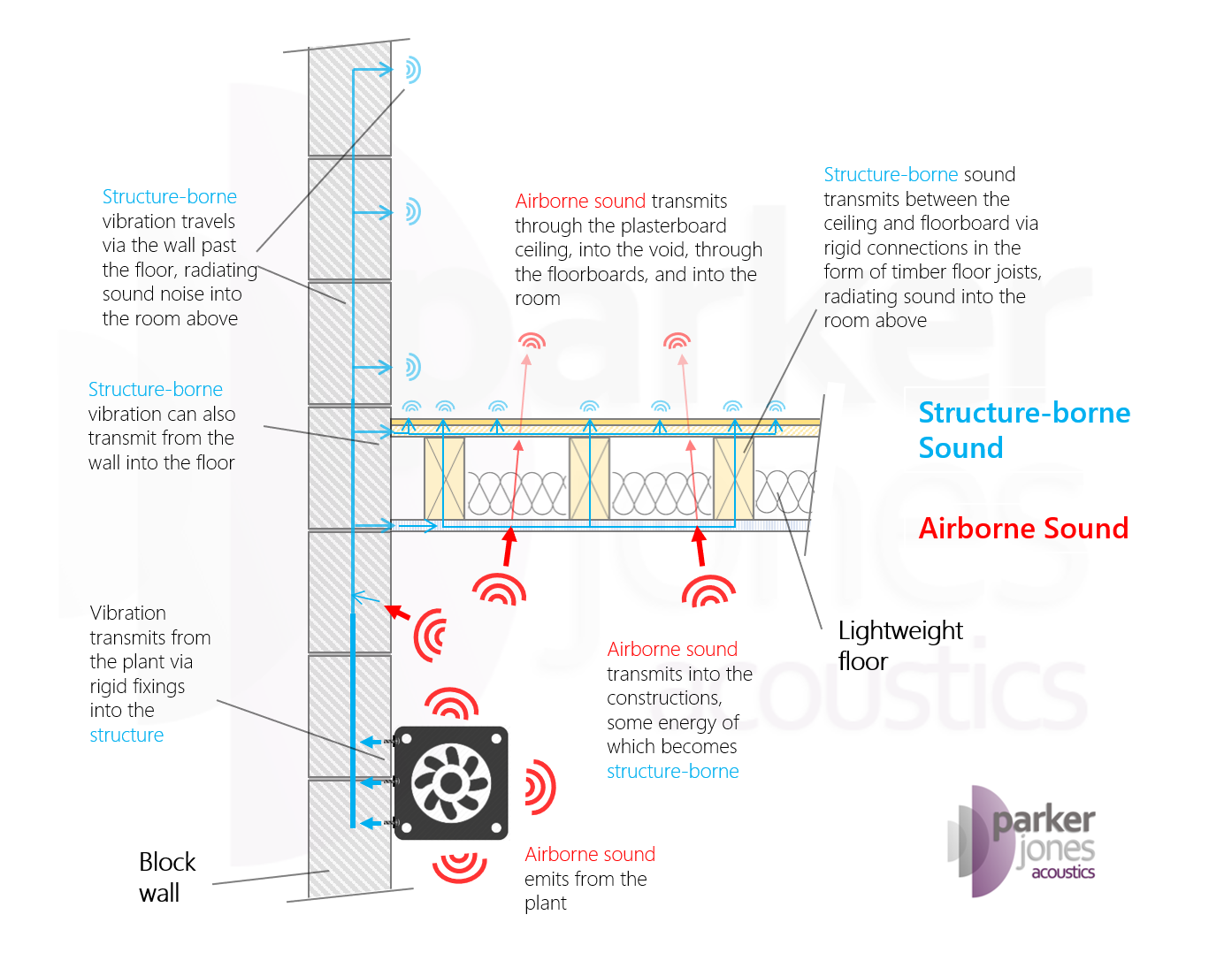Structure-borne sound
Sound is caused by vibrations which transmit through a medium and reach the ear or some other form of detecting device. Sound is measured in loudness (decibels (dB)) and frequency (Hertz (Hz)).
Sound in the built environment tends to be structure-borne or airborne.
Building Regulations Approved Document E - 'Resistance to the passage of sound' describes structure-borne sound as, ‘...sound that is carried via the structure of a building’. Structure-borne sound results from an impact on, or a vibration against, a part of a building fabric resulting in sound being radiated from an adjacent vibrating surface. A typical example of structure-borne sound is footsteps on a floor which can be heard in a room below.
Structure-borne sound comprises five processes:
- Generation – the source of an oscillation.
- Transmission – the transfer of oscillatory energy from the source to the structure.
- Propagation – the distribution of energy throughout the structural system.
- Attenuation - when waves moving through structures encounter structural or material changes they can be partially reflected which reduces the energy transmitted, and so attenuates the sound.
- Radiation – the emission of sound from an exposed surface.
Structure-borne sound and airborne sound are sometimes considered to be separate entities but they are closely related. Structural vibrations may radiate from surfaces, creating airborne sound, and airborne sound may cause an element of the building fabric to vibrate when it encounters a surface.
Structure-borne sound can be reduced by:
- Carpets and pads.
- Resilient underlay – which can have a similar effect to carpets and pads. Generally, they are made from recycled rubber, rigid fibreglass, foam or other such materials.
- Resilient mounts, sound clips or spring ceiling hangers.
- Soundproofing compounds. Typically the compound is applied between two rigid materials, such as subflooring. The compound dissipates the vibrations caused by sound waves as they move through the structure.
- A suspended ceiling system, raised floor or secondary wall structure.
- High mass constructions that include cavities or offset constructions to prevent transmission of vibrations.
Careful consideration must be given to structure-borne sound when designing buildings. However, the nature of structure-borne sound varies significantly depending on the source of the vibration, the composition of the structure through which it transmits, the radiating surface and the character of the receiving space. This is a complex subject and the design of sensitive spaces such as recording studios can benefit from the advice of an acoustic consultant.
Building Regulations Approved Document E - 'Resistance to the passage of sound' sets minimum standards for impact sound insulation. Impact sound transmission is typically measured in-situ with a tapping machine which uses steel-faced hammers to strike a test surface and generate sound in an adjacent space which can be recorded or monitored. This is useful only in giving an indication of the likely level of impact sound as it does not accurately represent the variety of impacts that might be experienced in practice.
The diagram below provides an example of structure-borne noise paths compared to airborne noise paths, for an item of mechanical plant, transmitting sound into a room above. (Credit: ParkerJones Acoustics)
[edit] Related articles on Designing Buildings Wiki
- Acoustic design for health and wellbeing.
- Acoustics.
- Acoustics in the workplace.
- Airborne sound.
- Approved Document E.
- Ash deafening.
- Building acoustics.
- Building Bulletin 93: acoustic design of schools.
- Building regulations.
- Decibel.
- Impact sound.
- Flanking sound.
- Noise nuisance.
- Pre-completion sound testing.
- Reverberation time.
- Robust details certification scheme.
- Sound absorption.
- Sound frequency.
- Sound insulation.
- Sound reduction index (SRI).
- Sound v noise.
- Underlay.
Featured articles and news
Welsh Skills Body (Medr) launches ambitious plan
The new skills body brings together funding and regulation of tertiary education and research for the devolved nation.
Paul Gandy FCIOB announced as next CIOB President
Former Tilbury Douglas CEO takes helm.
UK Infrastructure: A 10 Year Strategy. In brief with reactions
With the National Infrastructure and Service Transformation Authority (NISTA).
Ebenezer Howard: inventor of the garden city. Book review.
The Grenfell Tower fire, eight years on
A time to pause and reflect as Dubai tower block fire reported just before anniversary.
Airtightness Topic Guide BSRIA TG 27/2025
Explaining the basics of airtightness, what it is, why it's important, when it's required and how it's carried out.
Construction contract awards hit lowest point of 2025
Plummeting for second consecutive month, intensifying concerns for housing and infrastructure goals.
Understanding Mental Health in the Built Environment 2025
Examining the state of mental health in construction, shedding light on levels of stress, anxiety and depression.
The benefits of engaging with insulation manufacturers
When considering ground floor constructions.
Lighting Industry endorses Blueprint for Electrification
The Lighting Industry Association fully supports the ECA Blueprint as a timely, urgent call to action.
BSRIA Sentinel Clerk of Works Training Case Study
Strengthening expertise to enhance service delivery with integrated cutting-edge industry knowledge.
Impact report from the Supply Chain Sustainability School
Free sustainability skills, training and support delivered to thousands of UK companies to help cut carbon.
The Building Safety Forum at the Installershow 2025
With speakers confirmed for 24 June as part of Building Safety Week.
The UK’s largest air pollution campaign.
Future Homes Standard, now includes solar, but what else?
Will the new standard, due to in the Autumn, go far enough in terms of performance ?
BSRIA Briefing: Cleaner Air, Better tomorrow
A look back at issues relating to inside and outside air quality, discussed during the BSRIA briefing in 2023.
Restoring Abbotsford's hothouse
Bringing the writer Walter Scott's garden to life.
Reflections on the spending review with CIAT.
























